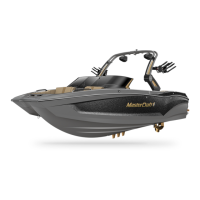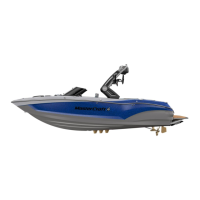2016 OWNERS MANUAL / 0399
Follow the instructions on the brake fluid container. Avoid shak-
ing the brake fluid container, and pour fluid slowly to minimize air
entrapment. Let the fluid in the reservoir stand until it is completely
free of air bubbles.
IMPORTANT: Before bleeding the brake lines, bleed the actuator
master cylinder. This is mainly required if a new master cylinder
has been installed, or if the master cylinder was run dry or is low on
fluid. To do so, remove the plastic access cover on the top of the
actuator housing and insert a flat blade screwdriver between the
rear bracket/tab and the fixed tab. The fixed tab is between the
rear bracket/tab and the front (E-brake release) tab. While holding
down the front tab, and using a slow/controlled motion, cycle the
screwdriver fore-aft to pump the master cylinder push rod
Start the bleeding procedure on the brake farthest from the master
cylinder.
At the brake assembly, connect a transparent bleeder hose to the
bleed screw fitting on the caliper and submerge the free end into a
container partially filled with brake fluid. Do not reuse this fluid.
The first person should stroke the push rod slowly while holding
the safety release bracket down. The second person opens the
bleed screw fitting. Then close the bleed screw fitting BEFORE the
first person SLOWLY releases the push rod. Repeat this procedure
until the fluid expelled from the bleeder hose is free of air bubbles.
Remember to always tighten the bleeder screw before releasing the
push rod. During this procedure, the master cylinder reservoir fluid
level must be maintained at no less than half full.
Repeat Steps 4 and 5 for the other brake, as well as the brakes
on the front axle of tandem axle trailers, or the center then finally
the front on triple axle trailers. If installation is on a tandem-axle or
triple-axle trailer, repeat the bleeding procedure on the rear axle(s)
brakes for a second time to assure purging of all air in the system.
Push down on the safety release bracket to ensure that the push
rod is in the released position.
After the bleeding is completed, recheck the fluid level in the master
cylinder. Fill the master cylinder reservoir to 1/8” from the bottom of
the threads on the reservoir cap. Do not overfill.
As a final check after bleeding is completed, stroke the push rod
and check to be sure the brake system is pressurized. This is done
by attempting to rotate a tire around.
It is highly recommended to check the function of the brakes prior
to running down the road. Attempt to back-up the trailer (preferably
up and incline) without the wiring harness connected. This should
activate the brakes to verify they are working as expected. If an
incline is not available, and with the wiring harness disconnected
as well, attempt to back-up the trailer against a wheel chock hard
enough to slide the actuator rearward into the frame and engage
the brakes. Remove the wheel chock and continue to back up to
verify the brakes are engaging.

